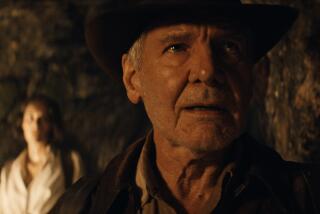Adding Facts to Indianapolis Saga : * Stage: John Ferzacca tries to bring added insight into the wartime tragedy with his latest version of ‘The Failure to Zig-Zag’ at OCC.
- Share via
COSTA MESA — Like a lot of people who saw “Jaws” in 1975, John Ferzacca was moved by more than just the film’s scenes of a catamaran-sized shark terrorizing everything in sight. He also was struck by the scene in which Robert Shaw, playing the crusty Quint, recalled the fate of the heavy cruiser Indianapolis, the ship he was stationed on at the end of World War II.
Quint described in detail how most of the crew died after the ship was sunk by a Japanese sub. His recounting dwelt on the schools of sharks that repeatedly attacked the sailors as they struggled to stay afloat while waiting for the rescue that didn’t come for five days.
Those images, however sensational (and, it turns out, not completely accurate), stayed with Ferzacca and helped inspire his own retelling of the ordeal for the stage. The Orange Coast College drama instructor finished “The Failure to Zig-Zag” in 1978, and it was staged by the Laguna Playhouse later that year.
Since then, “Zig-Zag” has been produced more than a dozen times across the country and as far away as Mexico City. Ferzacca has rewritten it often, taking the play from a courtroom drama to a piece that encompasses more of the disaster’s events and, he believes, deals honestly with the facts. His latest revision will open at OCC tonight and continue through Nov. 17.
“I’ve tried to give a truthful but artistic (version) of what happened while making the horrendous side of it clear,” said Ferzacca. “This revision covers more territory than (I did) originally.
“Combining drama and documentary has been my goal,” he continued. “There are scenes of the men in the water after the sinking, scenes that go back to the courtroom (where Indianapolis skipper Capt. Charles Butler McVay was court-martialed) and even scenes that flash-forward to the first reunion of the survivors in 1960. It’s quite a story.”
The facts of the Indianapolis, once obscure but now clearly documented, are these: The flagship of the 3rd Fleet left San Francisco on July 16, 1945, on a classified mission to deliver a cache of uranium and other components to Tinian island in the Pacific. There, the atomic bomb would be assembled aboard the Enola Gay and dropped on Hiroshima.
After completing its mission, the Indianapolis began heading to a home base in the Philippines but was torpedoed by a Japanese submarine. Some 850 of the ship’s crew of 1,200 men initially survived but were adrift for five days. When rescue finally came, only 316 were still alive.
They died from dehydration, exposure, fatigue, salt-water poisoning, burns, drowning and shark attacks. Some, weakened by the ordeal, were washed off lifeboats; others fell asleep and drowned. A few went mad, diving under water in pursuit of hallucinations of fresh water and food.
The lasting question concerned the belated rescue. The Navy has stated a policy against tracking the progress of classified missions and reporting the arrival (or failure to arrive) of combat ships. The few survivors were found by Army Air Corps planes on patrol in the area. McVay was later charged with failure to issue a timely order to abandon ship and failure to keep the ship on a zig-zag course.
Ferzacca, like many others, believes that McVay was chosen as a scapegoat for a tragedy that threatened to undermine the country’s joy that the war was over. He said his conclusions are based on extensive research, both in transcripts of the case and books written on it, and his own interviews with survivors and McVay’s son, Kimo McVay, who lives in Hawaii.
“(The survivors) all seem to hold on to the details of their experiences so clearly, they make very good witnesses,” said Ferzacca. “They have a lot of stories, but they’re basically the same story, of being covered with oil and trying to live through the exposure, the hot sun.”
One thing he learned is that few men actually were beset by sharks. “There were so many men dead already that the sharks had it easy; they didn’t have to take live men. There were some attacks, but the main problem was from the other factors. Many sailors just slowly died.”
Because of his knowledge, Ferzacca was hired as a consultant for CBS’ “Mission of the Shark,” which aired in late September and starred Stacy Keach as McVay. Like television critics who felt the story was too big for a made-for-TV movie, Ferzacca had misgivings about the final product.
“No, I wasn’t happy with it. There were many things that bothered me, especially how they sensationalized everything. But I guess that’s the nature” of Hollywood.
On a more positive note, Ferzacca has come to see “The Failure to Zig-Zag” as, among other things, a testament to the survivors of the Indianapolis.
In keeping with that sentiment, the college has invited dozens of survivors now living in California to tonight’s performance. Campus spokesman Jim Carnett expects a good turnout: “We’ve asked about 25 to come and we’re optimistic that many will show. It could be a special experience.”
* John Ferzacca’s “The Failure to Zig-Zag” will open tonight at 8 p.m. at Orange Coast College’s Drama Lab theater, 2701 Fairview Road, Costa Mesa. Performances will continue Thursday through Saturday at 8 p.m. through Nov. 16 with a 3 p.m. matinee Nov. 17. Tickets: $6 to $7. Information: (714) 432-5880.
More to Read
The biggest entertainment stories
Get our big stories about Hollywood, film, television, music, arts, culture and more right in your inbox as soon as they publish.
You may occasionally receive promotional content from the Los Angeles Times.










